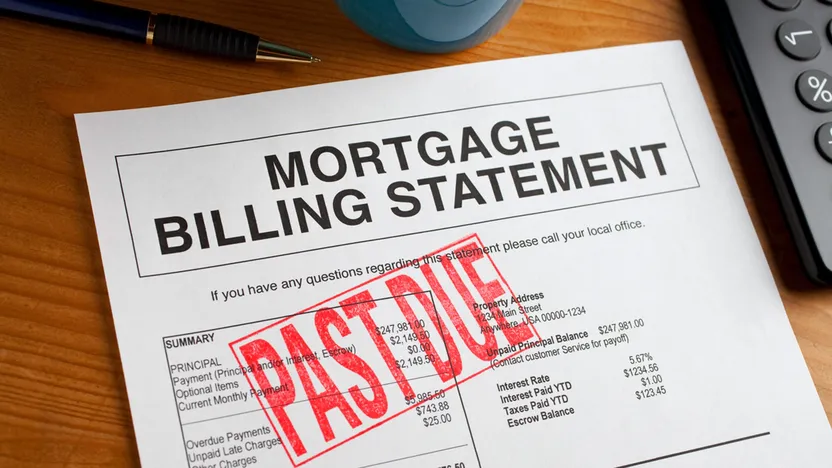By Daniel Bortz
Jan 29, 2023

What is a foreclosure? When a homeowner doesn’t pay their mortgage for an extended period of time, a lender will take possession of the home—which means the current owner must move out.
Foreclosure is a scary word and it’s become a real concern for homeowners as the economy continues to fluctuate. According to CoreLogic, the foreclosure rate (meaning the percentage of loans in foreclosure) currently hovers just under 3%.
If you’re struggling to make your mortgage payments, you’ll want to know what foreclosure means and how it works. Here’s what you need to know.
1. What is pre-foreclosure?
If you’re a few days late on a mortgage payment, don’t panic—the bank isn’t going to confiscate your house. In fact, most mortgage contracts have a 15-day grace period, with a late fee of 5% on payments made thereafter, says Jack Guttentag, author of “The Mortgage Encyclopedia.”
The real problem starts if you’re more than 90 days late on your mortgage payments, at which point the bank will issue a “Notice of Default” with the County Recorder’s Office. You’ll receive a letter in the mail notifying you that you’ve defaulted on your loan, and you typically have 90 days to pay off your most recent bill. During this stage, your house is technically in pre-foreclosure—meaning that the bank has not taken possession of the property yet. (That’s good news.)
If your house is in pre-foreclosure, your best move is to contact your lender to see if you can work out a repayment plan and avoid foreclosure. “The bank doesn’t want the property back,” says Beverley Hourlier, a real estate agent in San Diego. “They want you to be able to save it, but you have to take action. Don’t bury your head in the sand and stop opening the mail. Contact your bank right away, and they may be able to find a way to work with you.”
One way to save your home is through a mortgage reinstatement, whereby you “reinstate” your mortgage by making up all the missed payments at once, plus interest and lender fees. You’ll then go back to paying your monthly bill as usual.
If you can’t come up with the money, your lender will start the foreclosure process.
2. What is foreclosure?
When a property officially enters foreclosure, the lender will repossess the house due to lack of payment and sell it to recoup some of its money.
This process can take a while. For example, in Hawaii, the average time it took for a foreclosure to complete in 2022 was 2,546 days—the longest in the nation. Nationwide, the average foreclosure took 852 days—just over two years.
While the paperwork is winding its way through the never-ending bureaucracy, you don’t have to move out. But when the process is finished, you’ll receive a notice to vacate. (In most states, you have between five and 30 days to leave.) You’ll also receive a “Notice of Sale,” which states that the property will be sold at auction, and it lists the date, time, and location of the auction.
Your lender is required to publish the Notice of Sale in a newspaper in the county where the home is located for three consecutive weeks before the auction date. You still have the option to reinstate your mortgage up until five days before the auction.
3. What happens at a foreclosure auction?
Your home will be sold at a public auction to the highest bidder, who must pay the full amount for the purchase immediately. The buyer will receive a trustee’s deed once the sale is complete, at which point they become the official owner. But foreclosure auctions don’t always go as planned.
Unlike a traditional home sale—where an agent uses comparable properties (“comps”) to determine the sales price—mortgage lenders use a different formula to determine the listing price of a foreclosure. The starting bid usually includes the balance of the unpaid mortgage loan, interest owed, attorney’s fees, and costs generated by the foreclosure process—and together, those costs can sometimes push the asking price above market value.
If no buyer steps up to purchase the home, the lender becomes the owner. At that point, the home is considered a bank-owned or REO (real estate owned) property. Typically, the lender will then work with a real estate broker to put the property on the market. Generally, REO properties are sold “as is,” which means the lender is selling the home in its current condition and will make no repairs or improvements (or give the buyer any credits to fund fix-its).
4. What happens after a foreclosure?
If your home is foreclosed, the record goes on your credit report and can drop your credit score by as much as 300 points, or possibly more. It can hurt your ability to obtain a credit card, auto loan, or cell phone plan. A foreclosure remains on your credit report for up to seven years, but its impact on your credit score will diminish over time. There are also steps you can take to mend your credit score: Pay your credit card bills on time, spend within your means, and don’t take on new debt.
Foreclosure may be stressful, but there is plenty you can do to prevent it from happening—and repair the damage if it happens to you.
Source- https://www.realtor.com/advice/finance/what-is-a-foreclosure/






